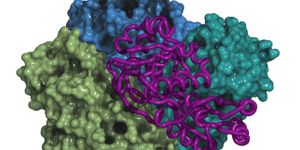Understanding a Rare Liver Disorder so it can be Treated
Scientists have learned more about a genetic disorder that affects the liver; the work also reveals potential new therapeutic avenues for treating the disease, Alagille syndrome. The researchers, from Sanford Burnham Prebys Medical Discovery Institute (SBP), have found the genes and cells that make liver ducts in zebrafish. These ducts are thin tubes that transport bile, a critical digestive fluid, from the liver to the gallbladder and the small intestine. People that have Alagille syndrome don’t have the necessary number of liver ducts; jaundice, liver disease, and subsequent liver failure is the result.
Zebrafish are a convenient research model in biomedical research for many reasons, including in the study of this disorder. "We use zebrafish to study Alagille syndrome because these vertebrates allow us to use experimental approaches that aren't possible with other disease models," explained Duc Dong, Ph.D. Dong is an Assistant Professor in the Human Genetics Program at SBP and the senior author of a Nature Communications paper reporting these findings. "Organ development, especially the liver, is highly conserved among vertebrates - including zebrafish - and the mutations we create in zebrafish alter embryogenesis in a manner consistent with humans, making it an ideal model system to study diseases such as Alagille syndrome."
Mutations in a gene called Jagged1 cause Alagille syndrome; mutations in the Notch2 gene can also cause the disease but are responsible for under one percent of cases. It affects around one in 70,000 births, and the disease not only impacts the liver but also affects the blood vessels, heart, kidneys, and some other tissues. There is no treatment for the primary symptom of the disease - loss of liver ducts.
"We wanted to gain further insight into the way Jagged works during liver development," said Dong. "We already knew that Jagged triggers Notch signaling in neighboring cells - a key step in the development of many organs, including liver. But a deeper understanding of how Jagged regulates duct cell formation in livers could shape strategies to help fix these structures to potentially spare the 10 to 30 percent of patients that eventually need a liver transplant."
Mutant zebrafish allowed the research team to identify the origin of Jagged signals. The investigators were surprised to find the source was endoderm-derived cells in the liver, initiating, or failing to initiate, duct cell identity there. This result is different from that found using mice, which laid the blame on a lack of Jagged signaling from cells in hepatic veins. Dong's team has shown how Jagged triggers Notch activity directly, creating all liver duct cells.
"Our findings are important because knowing the location and specific cell type that require Jagged expression gives us the information we need to target therapeutics to the right place to compensate for the lack of Jagged function in Alagille syndrome,” explained Dong. "And with advances being made in gene therapy using technologies like CRISPR/Cas9, our discoveries put us closer to being able to deliver genetic corrections of Jagged1 mutations.
"Because duct cells are lost due to a lack of Jagged function, and are not just malformed as previously thought, we now need to also consider regenerative therapeutic approaches to replace duct cells lost in this disease. Indeed, we have unpublished data suggesting that duct cells can regenerate when we allow normal Jagged function to resume."
"We are also exploring the possibility of using zebrafish to identify potential drugs that could alleviate pathologies caused by loss of Jagged function," Dong continued. "In fact, we are now gearing up for a chemical screen and working on finding funding for this project."
"This study shows the value in studying alternative disease models. In this case, zebrafish were critical for advancing our understanding of Jagged function in the liver, allowing us to devise new therapeutic strategies for Alagille Syndrome."
Sources: AAAS/Eurekalert! Via Sanford Burnham Prebys Medical Discovery Institute, Nature Communications









